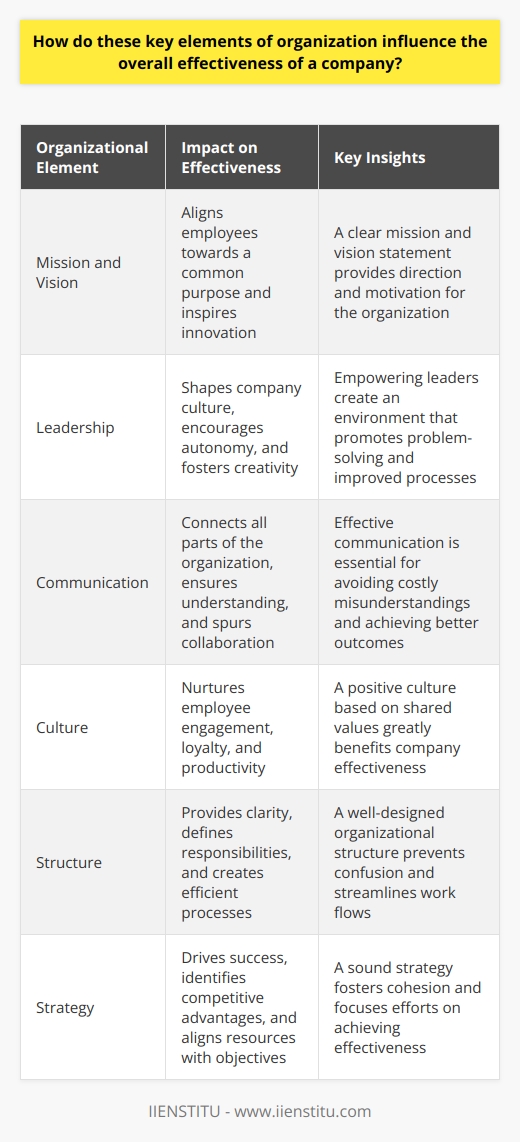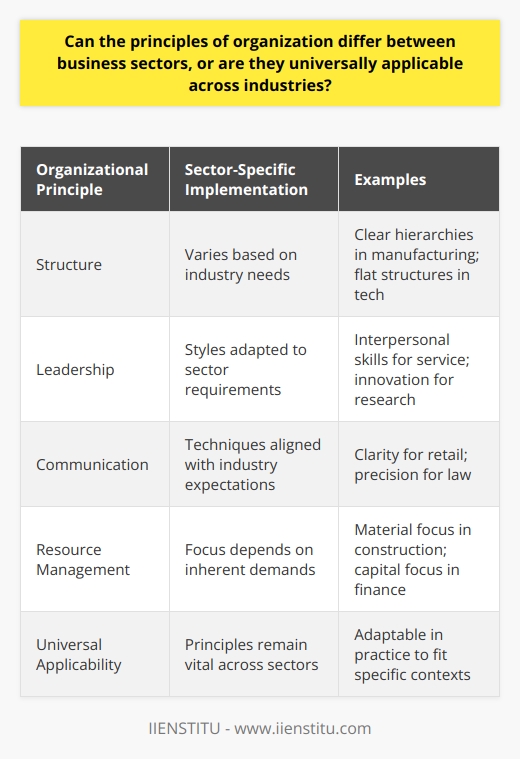
You know, when I first ventured into the bustling world of business, I was a tad naive. I thought all it took for a company to succeed was a brilliant idea and a dash of hard work. Well, let me tell you, I quickly learned there's a whole lot more to it than that! One of the biggest eye-openers for me was understanding just how crucial organizational structure and sound management principles are to a company's efficiency and overall success.
Back in the day, at my first startup gig, we had this incredible product. We were all so passionate and worked around the clock, yet somehow, things just weren't clicking. Deadlines were missed, team members were frustrated, and despite our best efforts, progress was snail-paced. That's when it dawned on me: without a solid framework aligning our goals, processes, and team dynamics, we were like a ship lost at sea without a compass.
The Journey to Grasp Organizational Structure
An Unexpected Lesson
I remember one chaotic afternoon—we were preparing for a major product launch. Everyone was running around like headless chickens, and communication was all over the place. Tasks were overlapping, some critical steps were overlooked, and stress levels were through the roof. One of my colleagues joked, "We're like a bunch of squirrels trying to cross a busy highway!" That chaos was a glaring sign that we desperately needed a well-defined organizational structure.
Building Blocks of Organizational Structure
Understanding the anatomy of an organization boils down to a few key components:
1- Hierarchy: Establishing clear lines of authority to avoid confusion.
2- Roles and Responsibilities: Making sure everyone knows their specific duties.
3- Communication Channels: Ensuring information flows smoothly and reaches the right people.
4- Centralization vs. Decentralization: Deciding how decision-making power is distributed.
By focusing on these elements, we began to see improvements:
Clarity in tasks, reducing overlaps.
Efficient decision-making, cutting down on delays.
Improved team morale, as everyone understood their value.
Diving into Different Organizational Models
From Functional to Flatarchy
Over the years, I've experienced various organizational structures:
Functional Structure: Departments are divided based on specialized functions—marketing, finance, HR, etc.
Divisional Structure: Separate divisions focus on specific products, markets, or regions.
Matrix Structure: Combines functional and divisional structures, employees report to multiple managers.
Flatarchy: A flat structure with minimal hierarchy, promoting collaboration and quick decision-making.
Each model has its own set of advantages and challenges. For instance:
Functional Structure: Great for fostering deep expertise but can create silos.
Divisional Structure: Increases focus on specific markets but may lead to resource duplication.
Matrix Structure: Encourages flexibility but can cause confusion due to dual reporting lines.
Flatarchy: Boosts innovation but may suffer from a lack of clear authority.
Personal Tales from the Trenches
At one midsized company, we transitioned from a functional to a matrix structure. Initially, it was like herding cats! People weren't sure who to report to, and priorities got mixed up. But once we ironed out the kinks, it led to improved collaboration and better resource utilization. We could respond faster to market changes and tailor our approach to different projects.
Core Principles of Management in Action
Planning and Strategic Direction
"A goal without a plan is just a wish," as the saying goes. Setting clear organizational goals and developing long-term strategies are paramount. Inspired by "The Art of War" by Sun Tzu, I learned that planning isn't just about the end goal but also understanding the competitive environment and preparing for uncertainties.
Key steps we took included:
Crafting a vision statement that resonated with all team members.
Developing SMART goals (Specific, Measurable, Achievable, Relevant, Time-bound).
Regularly reviewing and adjusting plans based on feedback and market trends.
Organizing and Allocating Resources
Efficient resource allocation ensures that every team member and asset is utilized effectively. In one project, we noticed that some teams were overloaded while others had capacity. By redistributing tasks and aligning skills with responsibilities, we saw a boost in productivity.
Some strategies we employed were:
Conducting a skills inventory to identify strengths.
Implementing a project management tool for better visibility.
Relationship Between Organizational Design and Corporate Culture: Organizational structure and corporate culture are inextricably linked, with the former profoundly influencing the latter. The design of an organization lays the groundwork for a culture to develop — be it one that promotes innovation, collaboration, or competition. Techniques to actively foster a positive culture through informed structural design are increasingly a topic of study, showcasing that corporate culture is not entirely serendipitous but can be shaped and directed through thoughtful organizational design.
Corporate Organization and Stakeholder Relationships: The selected organizational structure reaches beyond internal operations, influencing relationships with customers, employees, and others in the stakeholder ecosystem. Depending on the structural setup, organizations can nurture improved relations with these groups, enhancing loyalty and fostering mutual benefits. Various real-world structures show differing impacts on stakeholder satisfaction and engagement, underlining the importance of a well-considered organizational structure in the quest for holistic success.
Encouraging cross-training to build a more flexible workforce.
Leading with Effective Leadership Styles
Leadership isn't just about calling the shots; it's about inspiring and guiding your team toward success. Reflecting on Daniel Goleman's concept of emotional intelligence in "Emotional Intelligence: Why It Can Matter More Than IQ", we realized the importance of self-awareness and empathy in leadership.
Different scenarios called for different styles:
Directive: In crisis situations where quick decisions were needed.
Democratic: When input and collaboration enhanced the outcome.
Coaching: To develop team members' skills for the long term.
Boosting Business Efficiency with Organizational Design
Aligning Structure with Business Objectives
An organization's structure should be tailored to its specific goals. In our case, we aimed to optimize supply chain management process tips to reduce costs and improve delivery times.
We focused on:
1- Streamlining processes to eliminate bottlenecks.
2- Implementing technology, like inventory management systems.
3- Building stronger supplier relationships for better collaboration.
By aligning our structure to these objectives, we saw:
A 15% reduction in operational costs.
Improved customer satisfaction due to faster deliveries.
Enhanced ability to adapt to market changes swiftly.
Corporate Culture's Role in Success
Corporate culture and organizational structure are two peas in a pod. A supportive culture can significantly amplify the effectiveness of a well-designed structure.
We worked on:
Encouraging open communication to foster trust.
Recognizing and rewarding achievements to motivate staff.
Promoting work-life balance, understanding that happy employees are productive employees.
According to "Drive" by Daniel H. Pink, autonomy, mastery, and purpose are key motivators. We incorporated these elements to build a culture that not only retained talent but also attracted it.
Team Structure: The Heartbeat of Efficiency
Why Team Dynamics Matter
A company's success is often a reflection of its team's harmony. I've seen projects flop not because of technical issues but due to poor team dynamics.
Key factors influencing team efficiency include:
Trust and respect among team members.
Clear communication, avoiding misunderstandings.
Diverse skill sets, bringing various perspectives to the table.
Unique Examples from My Career
In one memorable project, we assembled a team with members from engineering, marketing, and customer service. Initially, there were clashes—engineers didn't understand marketing's ideas, and customer service felt left out. But by scheduling regular team-building activities and open forums, we broke down barriers.
The result?
A breakthrough product that met technical excellence and market needs.
Improved relationships across departments.
A model for future cross-functional collaborations.
The Ripple Effect on Stakeholders
Interconnection with Customers and Beyond
An organization's structure doesn't just stay within its walls; it spills over, affecting external relationships.
Customers: Responsive teams can address customer needs promptly, boosting satisfaction.
Employees: Clear structures provide career growth paths, enhancing retention.
Investors: Efficient management can lead to better financial performance, attracting investment.
Real-World Impact
After restructuring to a customer-centric model, we noticed:
Customer complaints decreased by 25%.
Employee engagement scores increased, as measured by annual surveys.
Investor confidence grew, reflected in a rising stock price.
Drawing It All Together
Reflecting on this journey, it's evident that organizational structure and management principles are not just theoretical concepts. They're living, breathing elements that, when nurtured, can propel a business to new heights. It's like tending to a garden—you need the right tools, knowledge, and a bit of patience, but the blooms are worth it.
Embracing these principles has not only made me a better manager but also enriched my professional relationships. And trust me, the satisfaction of seeing a team thrive and objectives met is unparalleled.
References
1- Sun Tzu. The Art of War. Translated by Lionel Giles, Race Point Publishing, 2017.
2- Pink, Daniel H. Drive: The Surprising Truth About What Motivates Us. Riverhead Books, 2009.
3- Goleman, Daniel. Emotional Intelligence: Why It Can Matter More Than IQ. Bantam Books, 2005.
4- Covey, Stephen R. The 7 Habits of Highly Effective People. Free Press, 1989.
5- Kotter, John P., and James L. Heskett. Corporate Culture and Performance. Free Press, 1992.
6- Sinek, Simon. Start with Why: How Great Leaders Inspire Everyone to Take Action. Penguin Group, 2009.
By weaving personal experiences with established theories, I've come to appreciate that the backbone of any successful business lies in its organizational prowess and management acumen. So, whether you're steering a startup or navigating a multinational corporation, remember that a well-crafted structure and strong principles are your compass in the entrepreneurial journey.
Frequently Asked Questions
What are the basic principles guiding organizational structuring in a business environment?
Introduction to Organizational Structure
In a business environment, organizational structuring plays a critical role. It determines how activities control, direct, and coordinate. Key principles guide this process. Leaders must comprehend these to craft effective, agile structures. Short sentences help us focus on each principle distinctly.
Division of Labor
Clear Task Allocation
Division of labor is fundamental. It enhances efficiency, fosters specialization, and increases productivity. Each member understands their specific responsibilities. Clear roles aid in streamlining business processes.
Hierarchy of Authority
Establishing Decision-Making Frameworks
A well-defined hierarchy of authority is essential. It shapes the decision-making landscape. Authority guides the flow of communication. It designates power dynamics within the organization.
Span of Control
Balancing Managerial Workload
Span of control pertains to oversight. It denotes the number of subordinates per manager. A narrow span may lead to micromanagement. A broad span might result in under-supervision. Balance is key for effective management.
Centralization vs. Decentralization
Determining Decision Making Locus
Decisions can rest with few (centralization) or many (decentralization). Centralization streamlines decision-making. Yet, it might slow responsiveness. Decentralization empowers lower-level employees. However, it can complicate unified direction.
Formalization
Setting Rules and Procedures
Formalization involves established policies and procedures. It dictates the standardization of behavior. High formalization ensures uniformity and predictability. However, it may stifle innovation and adaptability.
Departmentalization
Grouping Based on Common Traits
Departmentalization allows for dividing organizations into units. Criteria can be function, product, geography, or customer. Each carries implications for coordination and resource allocation.
Coordination
Synchronizing Activities
Coordination ensures unity of effort. It ties different parts of the organization together. Coordination mechanisms align activities with objectives. Collaboration tools and regular meetings are common practices.
Chain of Command
Defining Reporting Relationships
The chain of command dictates reporting lines. It clarifies who reports to whom. Clear chains avoid confusion and overlapping authority.
Organizational Design
Adapting to Business Needs
Design adapts to internal and external factors. It may be mechanistic or organic. Mechanistic suits stable environments. Organic fits dynamic, uncertain landscapes. Businesses need designs that reflect their context.
Conclusion on Organizational Structuring
In conclusion, these principles offer a blueprint for structuring. Successful application results in cohesive, responsive organizations. It balances the myriad factors businesses face today. Leaders attuned to these can build structures that perform, evolve, and endure.

How do these key elements of organization influence the overall effectiveness of a company?
Key Elements of Organization
Organizations thrive on structure. Frameworks and systems underpin every successful company. This text delves into organizational elements. We uncover their influence on effectiveness.
Mission and Vision
A clear mission guides firms. It provides purpose. Employees align through this focus. A vision propels a firm forward. It inspires innovation. Workers strive for this future. Performance aligns with company goals. Thus, effectiveness gains momentum.
Leadership
Leadership steers the ship. Leaders shape company culture. Their actions set norms. Employees take cues from them. Empowering leaders encourage autonomy. This autonomy fosters creativity. Creativity leads to problem-solving. Effective problem-solving equals improved processes.
Communication
Effective communication is key. It connects all organization parts. Clear messages ensure understanding. Misunderstandings are costly. They disrupt workflow. Effective communication spurs collaboration. Collaboration yields better outcomes. The result is a more effective company.
Culture
Culture embodies shared values. Values influence behavior. Positive culture nurtures engagement. Engaged employees work harder. They show more loyalty. Their productivity soars. Hence, company effectiveness benefits greatly.
Structure
Organization structure provides clarity. It outlines hierarchical levels. These levels define responsibilities. Clear responsibilities prevent confusion. Employees know their roles. They understand expectations. Work flows without obstacles. Structure creates efficient processes. Efficiency is central to effectiveness.
Strategy
A sound strategy drives success. It maps out progress. It identifies competitive advantages. These advantages allow for better positioning. A company with focus excels. Strategy aligns resources with objectives. Alignment fosters cohesion. Cohesion streamlines efforts. Streamlined efforts lead to effectiveness.
Systems and Processes
Systems organize work. Processes guide actions. Good systems save time. They reduce errors. Processes ensure consistency. Consistency leads to quality. Quality products or services draw customers. More customers mean business growth. Growth signals organizational effectiveness.
Decision-Making
Decision-making impacts outcomes. Swift, informed decisions keep momentum. Decisions reflect critical thinking. Critical thinking involves analysis. Analysis extracts insights. These insights prompt intelligent change. Intelligent change leads to competitive advantage. Advantage translates to effectiveness.
People
People are the core. Skilled workers drive innovation. Their knowledge is invaluable. They solve complex problems. A diverse workforce brings perspectives. Different perspectives spawn creativity. Creativity solves customer problems. Solutions enhance customer satisfaction. Satisfied customers equate to success. Thus, people are integral for an effective organization.
Technology
Technology powers efficiency. It automates routine tasks. Automation frees up time. Employees focus on strategic tasks. Technology fosters better data analysis. Informed decision-making hinges on data. The right tools provide insights. With insights, companies can adapt quickly. Adaptability is critical in a fast-paced market. Technology aids in maintaining cutting-edge effectiveness.
In conclusion, organizational elements intertwine intricately. Understanding their influence is vital. Companies must fine-tune these elements. It is a continuous task. Yet it reaps rewards in effectiveness and sustainability.

Can the principles of organization differ between business sectors, or are they universally applicable across industries?
Organizational Principles Across Sectors
Organizational principles serve as the backbone of effective business management. However, debates persist regarding their universal applicability. Key principles often include structure, leadership, communication, and resource management. These remain vital in any sector. Yet, their implementation demands customization to address unique industry challenges.
Structure Variances
The principle of organizational structure highlights hierarchies and workflows. Manufacturing firms lean on clear chains of command. This ensures precision and safety. Conversely, tech companies favor flat structures. These enhance creativity and rapid decision-making. Thus, while structure principles apply broadly, their embodiment differs per sector.
- Hierarchies in manufacturing
- Flat structures in tech
Leadership Styles
Leadership is another principle subject to sector nuances. Service industries often highlight interpersonal skills. These foster customer loyalty. Research and development leaders might stress innovation and risk-taking. Each sector molds its leadership style to its unique needs.
- Interpersonal skills for service
- Innovation for research
Communication Techniques
Effective communication is universally necessary. Still, its execution varies. Retail businesses need clear, concise communication with customers and between staff. In contrast, law firms depend on detailed, precise language. Communication techniques must align with industry-specific expectations.
- Clarity for retail
- Precision for law
Resource Management Differences
Resource management, including time, humans, and capital, is an overarching principle. A construction company’s focus on material logistics stands apart from a financial firm's capital allocation strategies. Industries manage resources according to their inherent demands.
- Material focus in construction
- Capital focus in finance
Universal vs. Sector-Specific Principles
To conclude, while principles of organization exhibit universal qualities, their application requires adaptation to industry-specific contexts. Executives must tailor these principles to fit the environment, competition dynamics, and regulatory landscape of their particular sector. Universal in form but adaptable in practice, organizational principles serve as flexible guides across the diverse landscape of business sectors.



